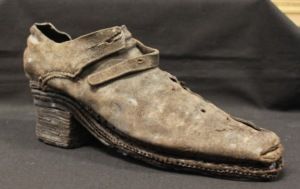News
These boots are made for more than walking – 500 years of Copenhageners’ shoes
This article is more than 8 years old.
You can really learn a lot about people and society from their old shoes

A man’s shoe from the end of the 1600s (photo: Copenhagen University)
A dissertation written by archaeologist Vivi Lena Andersen has analysed a decade’s worth of shoe discoveries – all 7,205 of them – that have come to light in excavation work in Copenhagen since 2007.
READ ALSO: So many shoes to choose from
If you thought that our forefathers’ shoes were primarily designed to keep their feet warm and protect them against the elements, then think again.
Vivi Andersen’s research has found that, just like today, fashion and social status played an important part when it came to choosing one’s footwear.
Fashion is really a killer
In fact, shoes have arguably become worse for our feet over time, partly because of technical developments, but also because fashions for things like high heels and pointed toes began to dictate the shape of the shoes.
“One of the reasons that shoe construction changed is the somewhat prosaic one that Copenhagen, like many other Medieval towns, had cobbled streets. This kind of surface is hard on both the feet and thinly-soled shoes, so shoemakers began to add heels and multi-layered soles. This also had the advantage that the shoes could be repaired and reused.”
Can’t tell right from left
When trying to determine how the old shoes were to walk in, Vivi Andersen received assistance from shoemakers and surgeons specialising in feet, as well as help from the personnel at the Nykøbing Falster Medieval Centre. This gave her invaluable information on how long the shoes might have lasted, how they interacted with people’s feet and, also, how different gaits have affected the shoes.
For example, in the 1500s, people thought that asymmetrical shoes were ugly, so they began to produce symmetrical shoes. Instead of a right and left shoe, you had two identical shoes that didn’t follow the natural form of the foot.
No gain without pain
Having identical shoes had the advantage that shoemakers only needed to use one last to sew the shoes on and they were cheaper to buy. On the other hand, they ruined people’s feet.
“Wear-marks on the shoes show that many Copenhageners walked with unnatural gaits because of their footwear, and that the shoes’ symmetrical, small, pointed styles and high heels resulted in inconveniences such as bunions, flat-footedness and hammer toes. However, that didn’t stop them from wearing shoes that were obviously damaging their feet. Status and fashion have been more important than healthy, warm and comfortable footwear.”
After the 1600s, it became more common for children to wear shoes – even before they could walk.
“That shows all too clearly that shoes don’t only perform a practical function, but are also status symbols that rich people can give their children to show how well they’ve done for themselves”, Andersen added.
So nothing much has changed there either!










































